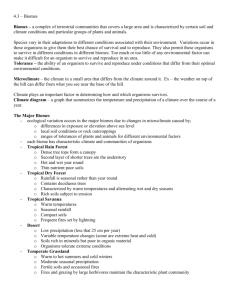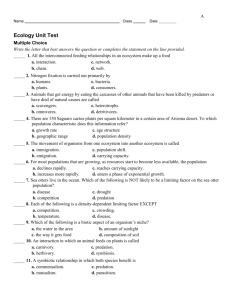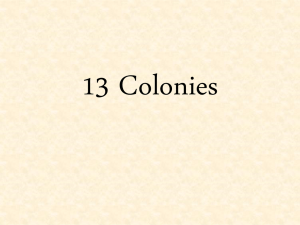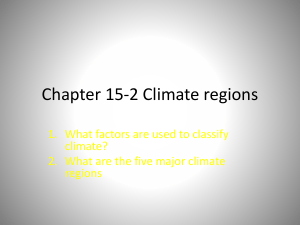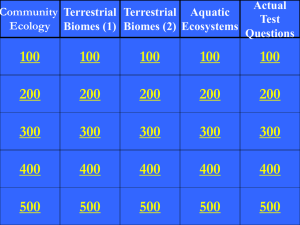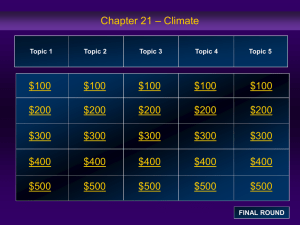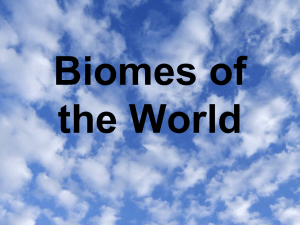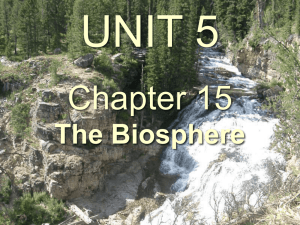Biomes
advertisement
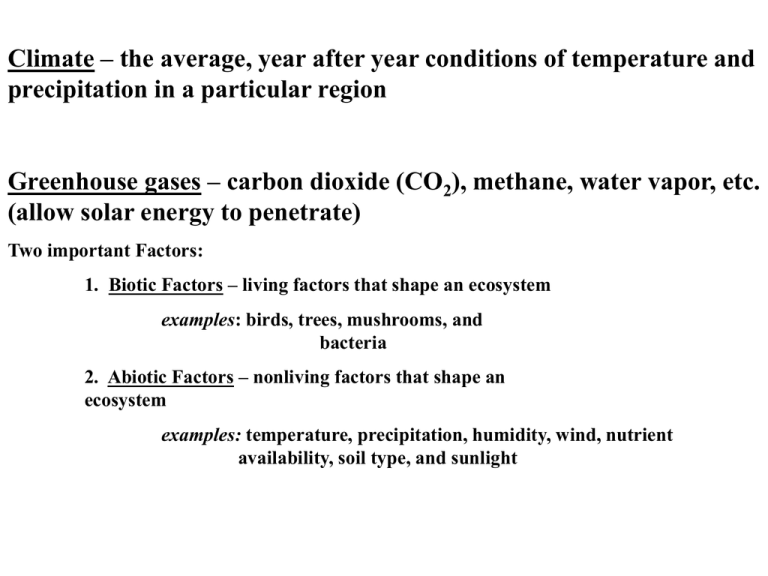
Climate – the average, year after year conditions of temperature and precipitation in a particular region Greenhouse gases – carbon dioxide (CO2), methane, water vapor, etc. (allow solar energy to penetrate) Two important Factors: 1. Biotic Factors – living factors that shape an ecosystem examples: birds, trees, mushrooms, and bacteria 2. Abiotic Factors – nonliving factors that shape an ecosystem examples: temperature, precipitation, humidity, wind, nutrient availability, soil type, and sunlight Biotic Abiotic Living Not Living Together, biotic and abiotic factors determine the survival and growth of an organism and the productivity of the ecosystem in which the organism lives. habitat – the area where an organism lives; an organisms “address” niche – the physical and biological conditions in which an organism lives and the way in which the organism uses those conditions; an organisms” occupation” examples: - place in food web (type of food eaten) - range of temperatures needed to survive - how it obtains food - when and how it reproduces No two species can share the same niche in the same habitat Community Interactions A. Competition - when organisms of the same or different species attempt to use an ecological resource in the same place at the same time - a resource refers to any necessity of life, such as water, nutrients, light, food, or space example: a tall tree blocking sunlight from a small tree B. Predation - when one organism captures and feeds on another organism - a predator is an organism that does the killing and eating - prey is the food example: cheetah is predator, gazelle is the prey C. Symbiosis - relationship in which two species live closely together 3 Main Classes of Symbiotic Relationships: 1. Mutualism - both species benefit - example: flowers and insects 2. Commensalism - one benefits and the other is neither harmed nor helped - example: barnacles and whales 3. Parasitism - one organism lives on or inside another organism and harms it - the parasite lives off of the host example: tapeworms, fleas, ticks, lice and mammals Biomes Biome – a particular physical environment that contains a characteristic assemblage of plants and animals 1. Tropical Rain Forest - more species than all other land biomes combined - organic matter that falls to the forest floor quickly decomposes and the nutrients are recycled - hot and wet year-round - thin, nutrient-poor soils - broad-leaved evergreen trees, ferns. large woody vines and climbing plants, orchids - sloths, jaguars, monkeys, parrots, butterflies, piranhas, boa constrictors, anacondas - found in parts of South and Central America, Southeast Asia, parts of Africa, southern India, and Northeastern Australia 2. Tropical Dry Forest - grow where rainfall is highly seasonal rather than year-round - during the dry season, trees drop their leaves (deciduous) - warm year-round - alternating wet and dry seasons - rich soils subject to erosion -tall, deciduous trees; orchids and bromeliads; aloes and other succulents -tigers, monkeys, elephants, rhinoceros, termites, snakes, and monitor lizards - found in parts of Africa, South and Central America, Mexico, India, Australia, and tropical islands 3. Tropical Savanna (Grassland) - warm, seasonal rainfall, compact soil - receives more seasonal rainfall than deserts but less than tropical dry forests - characterized by tall, perennial greasses and seomtimes drought-tolerant and five-resistant trees or shrubs - lions, leopards, cheetahs, hyenas, aardvarks, elephants, giraffes, antelopes, zebras, baboons, eagles, ostriches, storks, termites - found in large parts of eastern Africa, southern Brazil, northern Australia 4. Desert - dry (less than 25 centimeters per year) - soils rich in minerals but poor in organic material - cacti and other succulents - short growth cycles - mountain lions, gray foxes, and bobcats; mule deer, antelope, bighorn sheep, and kangaroo rats; owls, hawks, and roadrunners; ants, beetles, butterflies, flies, and wasps; tortoises, rattlesnakes, and lizards - found in Africa, Asia, Middle East, U.S., Mexico, South America, and Australia 5. Temperate Grassland (Plains and Prairies) - warm to hot summers; cold winters; moderate precipitation - fertile soils - occasional fires - perennial grasses and herbs (resistant to drought, fire, and cold) - coyotes and badgers, wolves, grizzly bears, mule deer, pronghorn antelope, rabbits, prairie dogs, bison, hawks, owls, prairie chickens, snakes - found in central Asia, North America, Australia, central Europe, and South America 6. Temperate Woodland and Shrubland - semiarid climate (somewhat dry) - hot, dry summers; cool, moist winters - thin, nutrient-poor soils - periodic fires - evergreen shrubs, oak trees - coyotes, foxes, bobcats, mountain lions, blacktailed deer, rabbits, squirrels, mice, hawks, quail, warblers, lizards, snakes - Found in western coasts of North and South America, areas around the Mediterranean Sea, South Africa, and Australia 7. Temperature Forest - cold to moderate winters; warm summers; year-round precipitation; fertile soils (rich in humus) - deciduous trees; some conifers (seed-bearing cones/needles); flowering shrubs; herbs; mosses and ferns - deer, black bears, bobcats, squirrels, raccoons, skunks, songbirds, turkeys - eastern U.S., southeastern Canada, most of Europe, parts of Japan, China, and Australia 8. Northern Coniferous Forest (“temperate rain forest”) - mild temperatures; abundant precipitation during fall, winter, and spring; relatively cool, dry summer; rocky, acidic soils - Douglas fir, Sitka spruce, western hemlock, redwood - Bears, elk, deer, beavers, owls, bobcats, weasel - Found on Pacific coast of northwestern U.S. and Canada, from northern California to Alaska 9. Boreal Forest (taiga) - dense evergreen forests of coniferous trees (spruce & fir) - long, cold winters; short, mild summers; moderate precipitation; high humidity; acidic, nutrient-poor soils - lynx, timber wolves, weasel, moose, beavers, songbirds and migratory birds - found in North America, Asia, and northern Europe 10. Tundra - has permafrost (a layer of permanently frozen subsoil) - strong winds; low precipitation; short and soggy summers; long, cold, and dark winters; poorly developed soils - mosses, lichens, sedges, and short greasses - migratory waterfowl, shore birds, musk ox, Arctic foxes, caribou, lemmings, and other small rodents - found in northern North America, Asia and Europe Aquatic Ecosystems Plankton – tiny, free-floating or weakly swimming organisms that live in both freshwater and saltwater environments Types: 1. Phytoplankton- single-celled algae 2. Zooplankton – animals A. Freshwater Ecosystems 1. Standing-Water (lakes and ponds) 2. Wetland -water either covers the soil or is present at or near the surface of the soil for at least part of the year a. Bogs b. Marshes c. Swamps B. Estuaries - formed where rivers meet the sea C. Marine Ecosystems 1. Intertidal Zone (once or twice a day submerged in sea water/ the rest of the time, exposed to air, sun, and temperature) 2. Coastal Ocean (the relatively shallow border that surrounds the continents) 3. Coral Reef (named for coral animals whose hard, calcium carbonate skeletons make up their primary structure) 4. Open Ocean (edge of continental shelf outward) 50011,000 meters 5. Benthic Zone (ocean floor)
